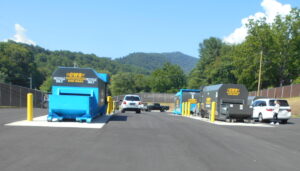
Recycling Convenience Centers – Pillars of Rural American Life
Recycling Trends in America
 In 1960, a little over 6 percent of municipal solid waste (MSW) was recycled. Today, it is over 35 percent.[1] Modern society has begrudgingly become more aware of the 3 R’s of sustainability (Reduce, Reuse, and Recycle). Reduction is most impactful to a sustainable society, but it directly contradicts our society’s entitlement to having every modern convenience at our fingertips. Reuse has certainly gained momentum and has even created fanatical trends in construction and remodeling and retro clothing sold through thrift stores and online auction systems and selling platforms such as Etsy, Facebook Marketplace, and Ebay. Finally, Recycling is the last line of defense before items end up in the landfill. People have always practiced sustainability, even if unintentionally, as a means to keep things from piling up in their homes. In the 1970s, recycling took more of an environmental bent as a signifier of our commitment to protecting the environment At the same time, many landfills near cities were filling up. As MSW landfill tipping fees were increasing in price, more communities became interested in the ability to recycle. Curbside recycling programs in urban areas addressed the convenience issue for many city dwellers making recycling achievable on a larger scale.
In 1960, a little over 6 percent of municipal solid waste (MSW) was recycled. Today, it is over 35 percent.[1] Modern society has begrudgingly become more aware of the 3 R’s of sustainability (Reduce, Reuse, and Recycle). Reduction is most impactful to a sustainable society, but it directly contradicts our society’s entitlement to having every modern convenience at our fingertips. Reuse has certainly gained momentum and has even created fanatical trends in construction and remodeling and retro clothing sold through thrift stores and online auction systems and selling platforms such as Etsy, Facebook Marketplace, and Ebay. Finally, Recycling is the last line of defense before items end up in the landfill. People have always practiced sustainability, even if unintentionally, as a means to keep things from piling up in their homes. In the 1970s, recycling took more of an environmental bent as a signifier of our commitment to protecting the environment At the same time, many landfills near cities were filling up. As MSW landfill tipping fees were increasing in price, more communities became interested in the ability to recycle. Curbside recycling programs in urban areas addressed the convenience issue for many city dwellers making recycling achievable on a larger scale.
Convenience Centers Are a Solution for Recycling in Rural America
But what about those who live in rural America? Environmentally-focused recyclers would cart their recycling off to private recycling centers, sometimes far from their homes. Driving far distances to recycle pollutes the environment, just in a different way. Publicly owned solid waste and recyclable material collection centers (aka convenience centers) help ease this problem by serving areas without the population density to support public curbside collection.[2] These centralized drop-off facilities are critical to rural areas, often serving as a pillar of many individuals weekly routines. Counties that utilize these centers reduce illegal dumping and provide a valuable service to residents, but poorly designed centers can become nuisance facilities, consuming municipal resources and time, from costs of personnel to equipment and materials transportation.
Designing Recycling Convenience Centers
 For decades, McGill has been working with counties to improve convenience centers, making them more efficient and streamlining traffic through these facilities. McGill takes an intentional approach to designing facilities with long-term planning for growth and commodity changes in mind. This might mean updating solid waste masterplans to consider future changes, from financial considerations and safety issues to sustainability measures and waste reduction goals.
For decades, McGill has been working with counties to improve convenience centers, making them more efficient and streamlining traffic through these facilities. McGill takes an intentional approach to designing facilities with long-term planning for growth and commodity changes in mind. This might mean updating solid waste masterplans to consider future changes, from financial considerations and safety issues to sustainability measures and waste reduction goals.
McGill also looks at the costs to users in their travel and use of the facilities. During site selection and the design process, McGill considers queuing considerations, such as the length of vehicle stacking lanes, waiting time for materials drop-off, the safety risks to users when dropping off materials, and the ability of operators to service the site. To increase traffic efficiency, McGill maximizes separation of user traffic from waste collection vehicles, develops appropriate way-finding signage, and designs the customer driving lanes and operator service lanes to create the most optimized traffic flow for the site.
Enhancing Recycling Convenience Centers
But what if convenience centers can be even more than just a place to drop off your waste and recycling? Some local governments are evaluating multiple uses of their convenience center properties and improving public perception of these centers. For example, McGill assisted with development of a master plan for a waste disposal site and a park in Burke County that contains a Southern Appalachian Bog. The park showcases the natural resources of the bog, while reducing the visual impacts of the adjacent convenience center.
What’s Next in Recycling Convenience Centers?
What do you think of your local convenience center? Does it need an upgrade? Contact McGill to learn how you can make improvements to your convenience center sites to make them more efficient, safer, and designed for the future. To learn more about we can help get your project off the ground, email info@mcgillassociates.com or visit our contact us page.
Read more about McGill’s solid waste services
References:
[1] https://www.history.com/news/recycling-history-america
